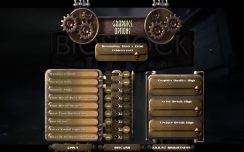BioShock
Publisher: 2K GamesBioShock was one of the best games to be released last year and is a ‘genetically enhanced’ first person shooter set in an underwater city called Rapture. The city was created at the bottom of the Atlantic Ocean by a man named Andrew Ryan as part of an ideological dream and is focused around a beautifully crafted 1930’s art-deco style.
2K Boston and 2K Australia have licensed and used Epic Games’ Unreal Engine 3 to great effect and have incorporated several DirectX 10 effects. These are all controlled via the ‘DirectX 10 Detail Surfaces’ option in the game’s graphics control panel.
As the game is based entirely under water, the developer has made great use of water shaders and, from what we have been told by 2K Games, there were two artists that worked only on making the water look truly stunning. The developers have used DirectX 10 to improve the water ripples when characters move through the water and there is massive use of pixel shaders to create wet-looking objects and surfaces.
Additionally, the DX10 version of the game uses the back depth buffer in order to create ‘soft’ particle effects; this is where the particle effects interact with their surroundings and overall look more realistic. There are other improvements to the game’s engine too – the developers have used DirectX 10’s DCF + texel offsets to improve shadow map filtering, which results in better-defined shadow edges.
As there is no in-built benchmarking utility, we have used FRAPS to record framerate over the course of three 90 second manual runthroughs in the Neptune's Bounty level. We averaged the three average frame rates recorded by FRAPS, but reported the median low framerate instead of the average in order to weed out the outliers.
We set the image quality slider to ‘high’, leaving global lighting and Vsync disabled. Anisotropic filtering was set to 16x in the game’s configuration files and, currently, Unreal Engine 3 does not support anti-aliasing under DirectX 10 mode. The game was patched to version 1.1.
Because the minimum frame rates were so high at 1680x1050, there was essentially no difference in the gameplay experience between all of the cards tested here. Yes, there were some quite large differences in average frame rates between the 8800 Ultra and the Radeon HD 3870, but given the fact that even the 3870 manages a 66 fps average framerate, you’re really not going to see a difference in performance at this resolution.
Once you move to 1920x1200 the 3870 X2 manages to push out ahead of the Ultra, but all cards deliver high enough frame rates to maintain pretty smooth gameplay. It could be argued that the only exception to this rule is the Radeon HD 3870, because its minimum frame rate drops below the 25 frames per second mark. However, I don’t think you’ll really notice that difference in most scenarios.
Things get interesting when we hit 2560x1600 though, as the 3870 X2 manages to bust out a pretty impressive lead over every other single card solution and it does so with a high minimum frame rate too. The interesting thing to note here is that the 3870 CrossFire configuration delivered similar performance but with a lower minimum frame rate. Despite there being a massive gap in performance between the 3870 X2 and the chasing pack of raging GeForces, that’s not to say that the other cards don’t deliver playable frame rates at this resolution – they just don’t deliver as good an experience as the 3870 X2 can deliver.

MSI MPG Velox 100R Chassis Review
October 14 2021 | 15:04










Want to comment? Please log in.